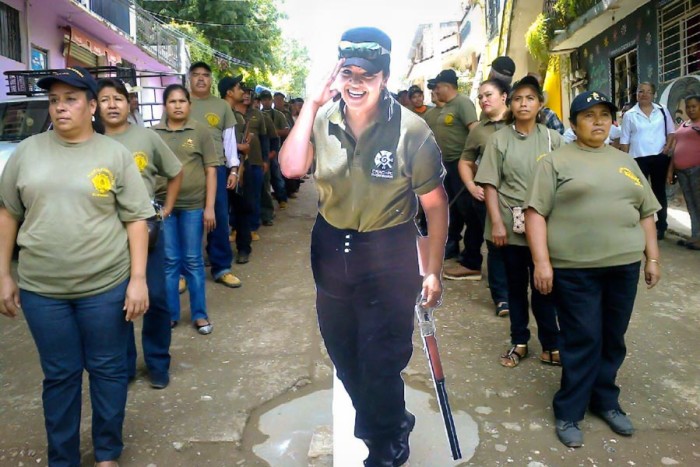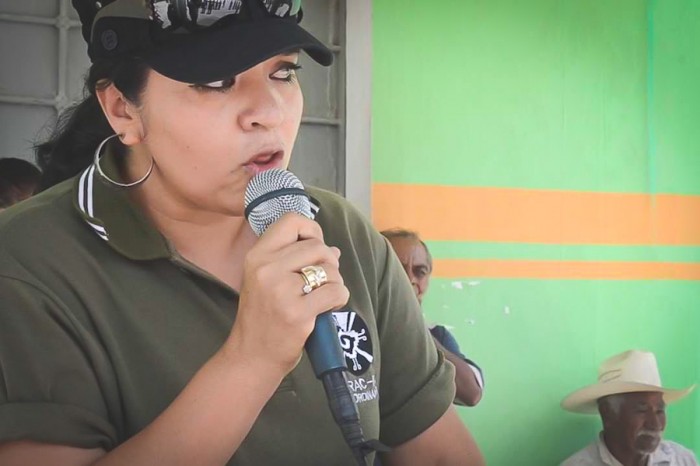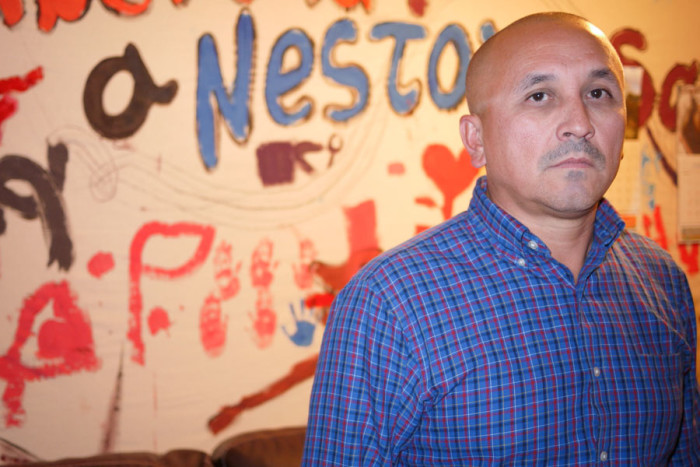
This story was reported in partnership with KUOW. Radio story by Liz Jones below. Listen in to 94.9 FM on Friday at 9 a.m. for more about Salgado’s case on The Takeaway
In a marked difference from the military green community police uniform she once wore, Nestora Salgado met me in a beige, knee-length dress with crochet detailing and Mary Jane flats. Her eyes were neatly lined black and her lips, cherry red.
The minimum-security prison in Mexico City doesn’t allow cosmetics — but you’d never guess she used ballpoint pen.
Outstretching her arms, Salgado, 43, gazed at her hands, gently curled due to nerve damage. She suffers from a nerve condition and also had a neck injury from a car accident more than a decade ago.
“I can’t move them,” she said in Spanish. “I’m telling my brain to move them, but they won’t move.”
Back when she was juggling three jobs in Renton to support her family, U.S. citizen Nestora Salgado never imagined herself atop a police car, megaphone in hand, combating the cartels in her hometown of Olinalá in Guerrero, Mexico.
She also never imagined she’d wind up in prison because of it.
For the past two years, though, Salgado has been stuck behind bars, accused by the state of Guerrero of kidnapping.
Guerrero state attorney general Miguel Ángel Godínez Muñoz and other Mexican authorities maintain Salgado crossed the line when the community police force she led detained three cocaine-dealing teenagers and a town official who Salgado claims worked closely with the cartels. Groups such as Mexico SOS that advocate for kidnapping victims and their families have argued that Salgado should not be released without a trial.
But among those demanding her release are dozens of human rights advocates, recently elected Guerrero Gov. Rogelio Ortega Martinez, and 13 Mexican senators, along with her supporters and family in Washington state. Mexico’s federal courts dropped similar charges filed against her, according to her lawyers, but state prosecutors in Guerrero continue to pursue it.
“You see how it would be to have a good country. I know Mexico is bad, because I lived a different life.”
Her attorney in Mexico, Ricardo Lagunes, met with Salgado’s Seattle-based lawyers, family members and human rights organizations in Washington, D.C., last month for a conference to plan strategy.
“We’re not focusing on fighting her case. … We’re focusing on getting rid of it,” Lagunes told me. “We’re dealing with a human rights case violation—a human rights crisis, here.”
Salgado tried to explain to me why a woman who lived a quiet life in Renton for 20 years chose to give that up to become La Comandante — or “the commander,” as others in the police force and the community called her.
“When you go to the U.S., you see how bad Mexico is by comparison,” she said. “You see how it would be to have a good country. I know Mexico is bad, because I lived a different life.”
The mother of three returned to Olinalá when she retired from work early, following a nearly fatal 2002 car accident that injured her neck and spine.
When she went back to Olinalá, she found the local government wasn’t doing enough to protect her hometown, increasingly rife with drugs, murder and extortion.
Salgado said she couldn’t just watch idly as the town suffered.
“These are my people. This is my land,” Salgado said. “I want to change the mentality here, and raise dignity and conscientiousness.”

Salgado says the community police force she led abided by Guerrero’s State Law 701, which allows indigenous groups to organize their own militias and regulating bodies to fight crime when the police fail to do so.
Salgado’s imprisonment hasn’t stopped Olinalá’s community police force. It continues to operate.
The local government initially encouraged the police force. The group helped reduce crime and take down the once-prevailing Beltrán Leyva cartel, Salgado said. When her crew arrested the teenagers and a town official, though, the government struck back.
On Aug. 21, 2013, the army arrested Salgado on kidnapping charges, which she denies. The soldiers showed her no arrest warrant. They provided no explanation, she said.
Salgado described her disbelief as the then-governor of Guerrero, Angel Aguirre, promptly whisked her on his private plane to the state of Nayarit’s maximum-security prison. There, officials placed her in solitary confinement.
“Still, I wasn’t scared, because I did nothing wrong,” Salgado told me of her initial arrest. “I didn’t ask for money; they weren’t hostages. I didn’t kidnap anyone.”
It didn’t take long for fear to creep up on Salgado, though. She was prevented from seeing her family, her accusers or her lawyer for much of her 21-month long maximum-security confinement.
Health repercussions from the car accident only worsened without treatment. Her emotional health, including her natural vitality that had barreled her to the top of the community police ranks, deteriorated with her body.
On May 5 this year, she began a hunger strike to protest prison conditions, the state of her case and widespread national corruption. She planned to continue the hunger strike for 43 days, in honor of Mexico’s 43 missing students from Ayotzinapa Rural Teacher’s College, also located in Guerrero.
“I didn’t ask for money; they weren’t hostages. I didn’t kidnap anyone.”
But on the 31st day, the international attention from her hunger strike resulted in her transfer to the medical unit at a Mexico City women’s prison, where she is now.
On a recent Saturday in Mexico’s capital, with a slight limp she led me to her hospital-like room at Tepepan prison’s medical tower. Anxiously awaiting surgery to remove a small tumor in her face, she just found out the procedure was rescheduled for another week. It could be cancerous, she said, but probably not. The doctors don’t know for sure. She needed to get an electrocardiogram beforehand, which didn’t happen on time. She didn’t know why.
Salgado sat in her colorless room with wide, restless eyes. While stuck inside the medical unit, she can’t go outside to see the sun, which she said “helps heal.” She can’t go play volleyball or use an exercise bike.
A three-inch-long scar lines the back of her neck — a leftover from surgery after the car accident that nearly killed her. She says she now suffers severe spinal complications, diabetes and muscle impairment, among other health issues.
She said she knows physical therapy could help her regain mobility in her fingers, ease her back trauma and lessen her slightly tapered gait.
While in prison, though, there is no physical therapy. “Believe me, I have asked,” she said.
For now, she has been prescribed a hefty dose of Gabapentin every eight hours, which helps ease neuropathy pain.
“I don’t know whether to scream or cry or what,” she said of her confinement. “To keep going, I have to be healthy, and I’m not.”
Salgado expressed immense frustration at the state of her case. “It’s not progressing at all,” she said.
In the U.S., the Sixth Amendment would mandate that the right to face one’s accuser and to a speedy trial. In Mexico the time limitations for court proceedings are not always enforced. As a result, cases like Salgado’s can drag on for years.
“To be an activist in Mexico is intolerable, but to be an activist and a woman, is unpardonable.”
Her accusers said they’d be willing to see her via videoconference, Salgado said, but she won’t have that. “I want to see them face-to-face,” she said. “I deserve that.”
Her accusers cited financial reasons for their failure to see her, Salgado’s attorney Lagunes said.
Salgado worries ceaselessly about her three daughters and nephew, who spend most of their time in Guerrero and fight alongside activists for her release.
Her oldest daughter, Saira Rodriguez, likewise expressed fear that someone will try to harm her children in attempt to get back at her mother. Because of this, bodyguards line her home. They accompany her when she takes her children to school. Rodriguez avoids public transit — just in case.
Jose Luis Ávila, Salgado’s husband who lives in Renton, said his daughters received death threats via Facebook. Unidentified gunmen shot and killed Ávila’s father, Eladio Ávila, in the state of Jalisco on May 20. No investigation regarding the murder occurred, Jose Ávila said.

But even behind bars, Salgado continues advocating. She recently wrote a memo calling a march for international solidarity on Oct. 27. She demanded justice for the murdered journalists and activists in the country, including photojournalist Rubén Espinosa.
A “Free Nestora” poster for the march in Guerrero, adorned with an illustration of Salgado framed by bursting maroon and mint-colored flowers, reads: “To be an activist in Mexico is intolerable, but to be an activist and a woman, is unpardonable.”
“If you raise your voice in Mexico, you face torture, death, jail,” Salgado said. “That has to change.”
Right now, Salgado is begging for more international support. While she has the support of Congressman Adam Smith, who represents her district in Renton, her family has not been successful in getting the State Department to put more pressure on Mexico to free her.
“Everyone who knows the love of a mother should be with me,” she told me. “I’m tired. I’m fighting against someone very powerful: the government. … I can’t do it alone. No one could do it alone.”
In Salgado’s high, calm voice and gentle demeanor, I saw a mother. In her determination, La Comandante shined through.
“My fight isn’t for Nestora. Nestora was fine in Washington,” she said. “My fight is ‘comun.’ ” That means, for everyone.
Previous Globalist coverage
Nestora Salgado accusers fail to appear in court; supporters mark anniversary
Nestora Salgado moved to medical unit in Mexico City prison
Renton woman Nestora Salgado on hunger strike in Mexican prison
Nestora Salgado’s family prepares for long court fight in Mexico in vigilante case
Mexican governor calls for release of militia leader from Renton
Political support grows for Renton grandmother-turned-militia-leader held in Mexico


Thanks for this excellent story about a courageous woman. The U.S. government should be demanding her release! Why is the State Department avoiding its responsibility to defend a U.S. citizen in this case?